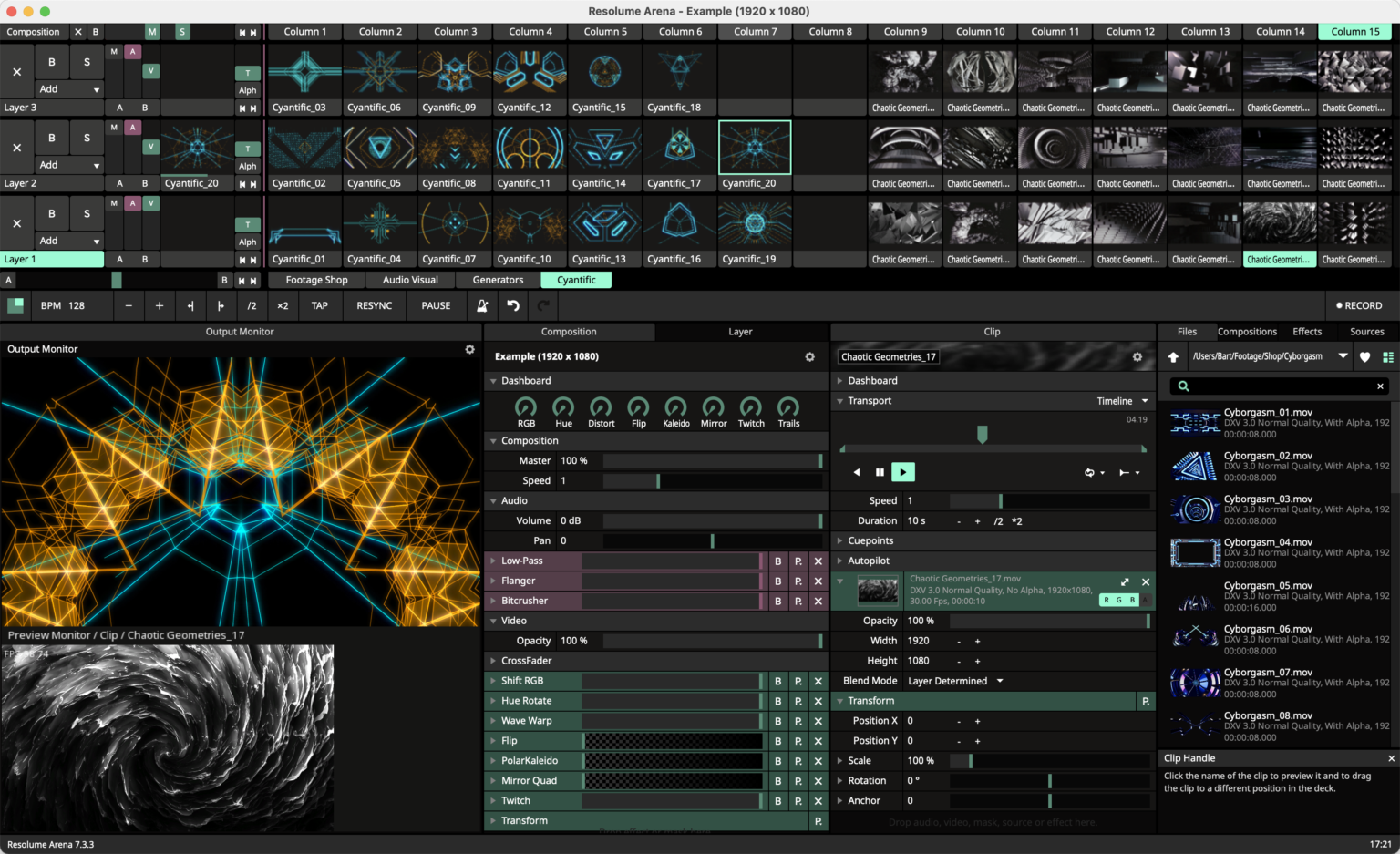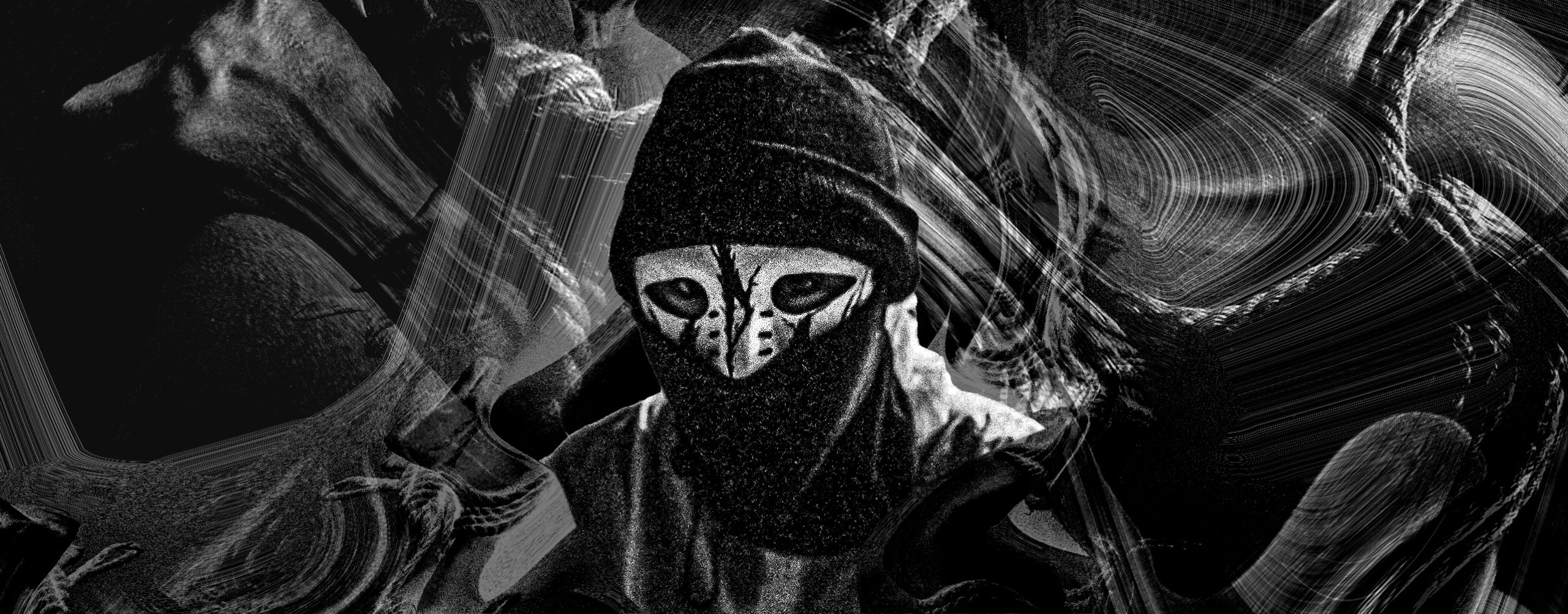Flipnormals is the pseudonym of the Ibiza-born digital visual artist who has now been living in Barcelona for 6 years. From a very young age he began exploring varied artistic branches related to design and editing, later on graduating in Video Game Design and Development in 2022. He began his career as a VJ (Video Jockey) at the end of 2019 and is currently the official VJ of Kompound Industrial (avant-garde collective of industrial techno and hardcore) and resident at Input Hight Fidelity Dance Club in Barcelona, in addition to doing work as a graphic designer and 3D animation.
What do we mean when we talk about making visuals?
When we talk about “making visuals” we refer to the live mixing of visual material in video format, following the rhythm and atmosphere of the music playing at the moment. This material is arranged on LED screens or projectors, and is controlled by a Video Jockey through MIDI controllers and a computer.
Could you tell us more about the visual work you do at Kompound?
For each party we do with Kompound, we create a new visual project. Sometimes we get the whole team together, come up with an idea and choose a place to shoot to start creating later. It’s a very artistic moment that we all enjoy, from painting mannequins and smashing them, to painting a 25 meter graffiti, going through the streets of our city like crazy, doing a fetish session with models or filming tuned cars drifting. Everyone has their role, for my part I’m in charge of recording and editing the material, among others.
We don’t always have the time to do all this though, so for those occasions, I create 3D animations to mix with the videos we already have.
It is very interesting to see all the material that is collected and mixed project after project. It is also something unique and exclusive, as it can only be seen in full at Kompound event.

Why do you think the visuals, lights and music complement each other? What does each add to the experience and why?
It is important to analyze these three elements separately to know the importance of each one and to understand the cohesion between them.
As an audience, we are used to attending musical events where there are always lights (moving heads, lasers, spotlights, strobes, etc…) but, what would happen if there was only music in the room and a constant light on? It would be such a visually poor situation that it would be difficult to focus on the music, to be individually with oneself and to feel that positive solitude that we like so much when enjoying music.
And the other way around, an event without music and only with lights? Well, there are artists who create these exhibitions, where they play with the movements of led bars or spotlights, and the result is closer to a feeling of peace, but it has practically nothing to do with a party. The same happens with the visuals, where it would be something like the silent movies of 100 years ago.
Everything changes when you put these elements together adding a good lighting rig to the music, controlled by an experienced light jockey who knows how to carry the room. For example, in moments when we get to a quiet part of the song, lights would accompany it with a constant but soft movement, in moments of rush, a strobe light could be used to give even more epicity, and when it breaks, increase the speed of the lights in addition to adding lasers. The interesting thing about this world is that the possibilities never end, and it depends on the interpretation of each operator.
If, in addition to this, we add the element of visuals controlled by a Video Jockey, what we get is a complete immersive experience. Normally the Light Jockey and the
Video Jockey work together, and as the Disc Jockey advances in his session, they comment on what they are going to do in each moment in order to get to know each other and their next moves. This gives rise to even more show possibilities, screen-only moments or light-only moments, charged moments of the session where everything is done at the same time, etc…
I think it is very important that as LJ and VJ the same people operate all night long, because if you just analyze song by song, it leads to too much repetition of the same elements. Keep in mind that there are many hours of party where several DJs play, but the audience is the same, and you have to know how to give visual breaks to get that momentary power. A clear example would be a movie with a lot of action in all the scenes, at the end you don’t care if that helicopter explodes or a building collapses, but if that only happens twice in the whole movie, the moments are much more shocking.

What excites you the most about visuals as a means of artistic expression?
What fascinates me most about mixing live visuals is the ability to tell a story, the relationship between the sound that enters through the ears and the images that enter through the eyes. I relate it a lot to cinema, where the meaning of a scene can change drastically depending on the music that accompanies it.
Being focused on industrial techno and hardcore parties, I try to find images from actions that transmit this adrenaline, even if they have nothing to do with each other. Painting illegal graffiti gives you a unique adrenaline rush, same thing with doing a backflip in a bmx, as well as a BDSM session. Putting these three images together with high BPM music and powerful drums gives a very interesting result.
Another thing I love is reacting live to the elements of the DJ set, the effects and stops that the DJ makes, the changes in the song itself… I take it as if it were a kind of video game where you can’t fail, when you nail the timing it gives an incredible feeling of satisfaction.
What effects does light have on the mood or physiological state? Thinking about events where this medium is used.
Generally, humans relate colors to emotions, red to passion or blue to melancholy, for example. In techno events it is important to correctly select the color that goes in each moment. It is true that if, for example, it is an industrial techno party, reds predominate, since the hardness of the bass drum and distortion of the sound give a feeling of seriousness and even anger when dancing and a softer color like blue, could give rise to a kind of ludonarrative dissonance, although it does not mean that it is wrong.
As a personal fact, I discovered a few months ago that I have synesthesia. I had been thinking for years that it was something normal in all people. So, there are times when I put aside objectivity and let myself be carried away by subjectivity when choosing colors. If for example the sound is “acid” for me it is totally necessary to use green or lilac depending on the tone, when it is a more melodic and soft sound, it revolves around blues, a dry bass drum without other elements is brown or yellow, and a long etcetera. I make the most out of this to try to transmit it to the public. Of course, in the end you also have to adapt to the club or promoter that has hired you and put aside your preferences.

What does the experience of playing live visuals feel like, and how can it equate to the work of a DJ doing a live set?
I have never in my life felt so comfortable doing a task as when I do live visuals for industrial or hardcore sessions, I like it even more than dancing. It’s an incredible experience where you unleash your emotions while transmitting them to the audience.
The comparison with the work of a DJ is complicated, but there are certain similarities, especially in terms of the method of operating using different types of MIDI controllers or other devices. One of the parts I like the most is the creation of the visual material, either through a video camera, or modeling and animating with 3D creation programs. In a live DJ set, it would be something similar to the DJ creating sounds prior to the event and then using them live by editing them and adding effects. In the same way, VJs mix this material and make it change visually through a myriad of visual effects that give us mixing programs such as Resolume Arena.

The most special part, is that the VJ must adapt to what the DJ does, it is a controlled improvisation and not a random thing, it has to make sense. On the other hand, it is important to note that the VJ operates all night (usually 6 hours, but it can be longer), so you must manage the material properly, and not use what is more impactful in the early hours, just because the song is worth it, because you have to think about the total duration of the event. In the same way that a DJ will not use all his best cards at the beginning of the live set.
I feel grateful to have discovered this world of visual digital art and see that it fits so well with me. Currently, being a VJ is not a very well known job, we are still seen as technicians and not as artists, since years ago visuals were just another decorative element that accompanied the lights. Little by little this is evolving, though, and we are realizing that it goes much further. From here I encourage all VJs who are starting to move forward, and between all of us to make known the true potential.
Get to know more about Flipnormals by following him on @_flipnormals_ .

